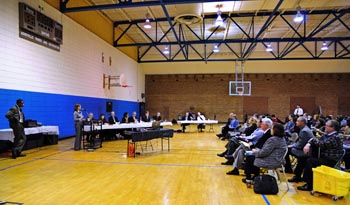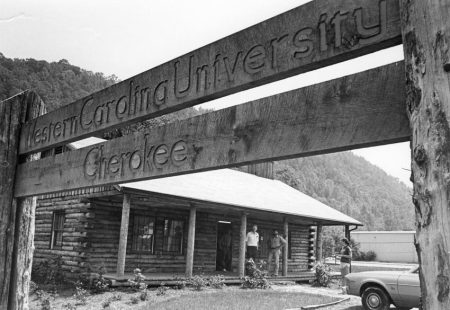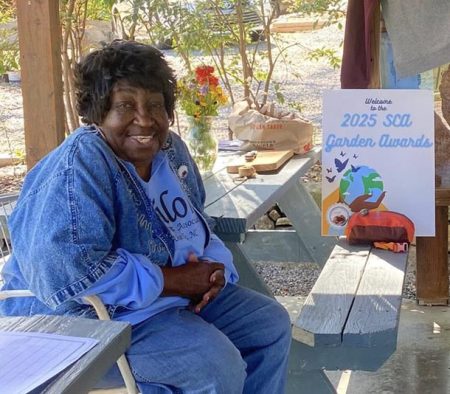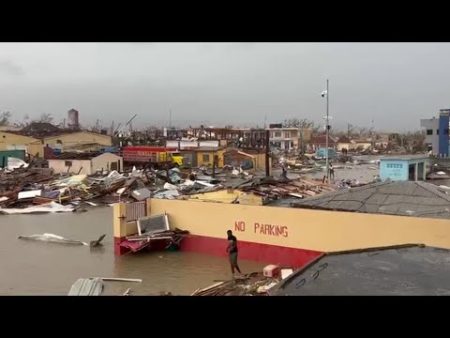City Council Meets with Central and Southside Community
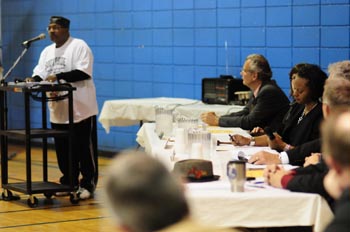 |
| Robert Hardy, President of the Southside Community Association, speaks to Mayor Bellamy and the Asheville City Council. Photo: Renato Rotolo |
by Johnnie Grant
Asheville City Council’s community outreach meeting on Tuesday, November 30 got off to an interesting start. The agenda included proposals on riverfront redevelopment, Mission Hospital construction and impact on area roads, Choctaw Greenway, the Clingman area Streetscape, and Asheville 2010: A Financial Crossroads. Of main concern to the Southside community was the proposal for an access road leading to A-B Tech.
Southside Community Organization President Robert Hardy took to the microphone to express concerns from the Southside community at large regarding the road, which could possibly take out the neighborhood’s only swimming pool at Walton Street Park. Hardy said he and other area residents want alternative routes to be considered that would not encroach on the park. “But, if it has to go,” said Hardy, “we want to make sure there will be a replacement pool built before the Walton Street Park pool is demolished.
“One of the studies we did,” continued Hardy, who was a student at A-B
Tech and went on to graduate with a B.S. degree, “was on traffic relief
and egress from A-B Tech. This showed an alternative route for Meadows
Road and bridge traffic. What happened to that pending project? Was it
completed, forgotten about, or could that study be revisited?”
Hardy also shared with the council information of concern from the
Southside organization regarding pedestrian traffic within the immediate
area. “Nothing has been done to protect students and pedestrians
walking to and from Asheville High School and A-B Tech along Oakland
Road. People are dodging cars and walking in muddy goat-paths trying to
keep themselves safe, while the City of Asheville has taken “stimulus
money” to paint bicycle lanes all around town! When can we expect a
sidewalk project on Oakland Road to happen? ” he asked.
Responding about the access road, Hank Dunn, president of A-B Tech, said
the road in question was still just a concept, and at present there was
no funding for it. “However,” he quickly added, “the current access
roads [to A-B Tech] are clogged on a daily basis, and should an
emergency or evacuation situation arise, this could present a potential
crisis.”
Roderick Simmons, Director of Asheville Parks and Recreation Department,
showed a slide presentation with images of the new Livingston Street
Center that will be completed in stages. When questioned about the
existing Reid Center structure he informed the community that the
$700,000 raised was not enough to rehabilitate the current site, which
is expected to cost approximately $4 to $8 million dollars. The audience
also asked about the new name, and Simmons confirmed that the new
center will be called “Livingston Street Center.”
Councilwoman Esther Manheimer spoke about the uniqueness of Asheville’s
daily changes in population. She explained that workers and commuter
traffic pour into Asheville every day, whereby the population expands to
around 140,000-150,000 people during working hours, but goes back down
to our 78,000 people after business hours. “This puts a tremendous
burden on the city’s infrastructure, and very few cities within the
state of North Carolina have this problem. We must find a workable
solution,” concluded Manheimer.
 |
| A number of people from the Southside and Central Asheville communities could be seen comparing and taking notes during the Asheville City Council Meeting. Photos: Renato Rotolo |
Councilman Cecil Bothwell added, “I don’t know enough about the proposed
road change to have an informed opinion. I’m certain that if such a
road proved to be a good idea and if it would eliminate the current
swimming pool, I would not vote to approve it until a replacement pool
was complete, presumably at the new Livingston Center.
“The development of the River District extending toward Southside seems
like a good change—reconnecting two parts of the city that have been cut
off from each other and from the rest of town due to failed ‘urban
renewal’ policies and the residual wreckage of our industrial past,”
concluded Bothwell.
City council members took a number of other questions from the audience
that were scribbled on comment cards and passed to different members of
City Council for their input. Some of the questions asked were:
Has Mission Hospitals purchased Lee-Walker heights? To which Asheville
Housing Authority Assistant Director David Nash answered, “No.”
Additional questions were asked about the access road leading to A-B
Tech. City staff said there was little they could say about the road at
such an early stage.
Hardy, however, had a great deal to say about the prospect.
“Clandestinely, and without collaboration,” said Hardy, “what people
have come to realize is these proposed projects have a real potential to
‘take legs,’ and receive federal funding. You should also understand
why the African American communities seem a little jaded when the city
officials show up. They [the city of Asheville] will then start tearing
up communities in the name of progress. It’s not that people opposed the
projects, but we — as community members, stakeholders, and taxpayers —
would like to participate as good stewards, and be valued resources in
the planning process.
He continued, “There are many African Americans born and raised in
Asheville who are college educated in various disciplines. These are
local people who pay taxes, and live within the city of Asheville. They
could have been, and can be, very effective and instrumental in the
master planning processes. However, a great many of these people have
not in the past, nor presently, been able to get jobs within our local
city or county government, or in construction.
“People are then brought in from other areas of the country, counties,
and states, and are clueless to what happened in the past. They
sometimes, by no fault of their own are delegated to push an agenda
without any informed forethought.
“Historically, that’s the way it has always been for Asheville —
especially within our [African American] communities, and we end up
suffering economically as a result.
“Isn’t it a strange irony that the city’s tax base is strained, as
explained by Mayor Bellamy, and maintaining the infrastructure of the
city greatly depends on property taxes and other local revenue?” said
Hardy. “Our city’s local African American community once provided a
hefty revenue stream from property taxes, businesses, and jobs within
the city of Asheville— until urban renewal came and destroyed these
communities of great earning potential—and now the city is broke.”
The 2010 Asheville City Land Use Plan encompasses the area within the
existing City limits, as well as the area outside the corporate limits.
Central
The Central Focus Area is generally bounded by Broadway and I-240 to the
North; Tunnel Road to the East; the Swannanoa River to the South; and
the French Broad River to the West. Neighborhoods situated within this
area include Montford, East Riverside, Downtown, Kenilworth, East End,
and the McDowell Street Area.
Urban Center/Urban Fringe
The Urban Center is bounded by I-240 to the North; Hilliard,
Grove/Blanton to the West; Choctaw to the South; and Biltmore Avenue,
South Charlotte Street and College Street to the East.
